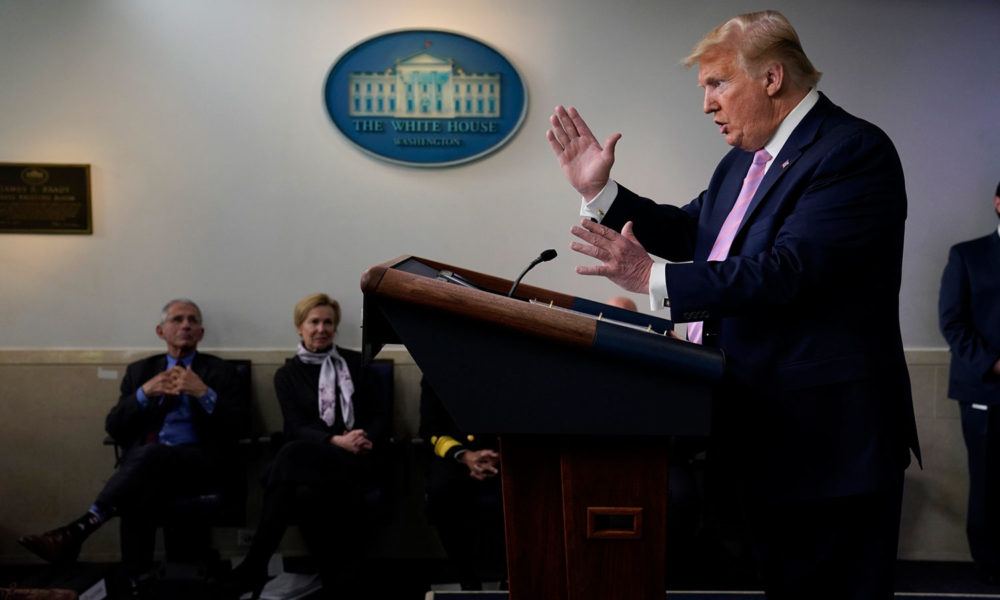Despite the incredible efforts of Dr. Anthony Fauci and other scientists in the White House Coronavirus Task Force, the Trump White House has pushed aside CDC scientists from communicating with the public during the COVID-19 pandemic, a new analysis by the Union of Concerned Scientists finds.
CDC recommendations are no longer announced by CDC scientists. Vital health information on the pandemic is now publicly filtered by political officials, who mischaracterize the science and spread harmful—even lethal—misinformation on a near-daily basis. By muzzling top scientists and health professionals, our government is depriving all of us of critical scientific information, just when we need it most to protect the health and safety of ourselves and our loved ones.
According to our newest analysis, Let the Scientists Speak: How CDC Experts Have Been Sidelined during the COVID-19 Pandemic, the current administration’s approach to COVID-19 strongly diverges from the ways that the George W. Bush and Barack Obama administrations responded to some of the worst public health crises in their tenures, the SARS epidemic in 2003 and the H1N1 (swine flu) epidemic in 2009, respectively. Our data suggest that, during three of the largest global epidemics of the 21st century, only the Trump administration prioritized the voices of political officials—particularly the president’s—in the public spotlight at the expense of top scientists and public health professionals.
The public is hearing less from the CDC than during prior epidemics. . .
COVID-19 is the greatest public health crisis seen in the United States in more than a century. However, in the first 13 weeks of the epidemic, the CDC has briefed the public 19 times on COVID-19, about as often as the agency had briefed the public on SARS (18). But SARS affected only eight people in the US; in comparison, COVID-19 affected over 97,000 times more people in the US during the same timeframe. According to the latest estimates, nearly 1.5 million people have tested positive for the novel coronavirus in the US.
This is dramatically at odds with how the US government normally approaches public health problems. According to a study by the National Institutes of Health (NIH), the more death and suffering a disease causes, the more the US government devotes resources for scientists to tackle the problem. If the public is hearing less from the CDC on COVID-19 than during past epidemics, this likely indicates that CDC scientists are being hindered from speaking to the public.

. . . and hearing more from political officials
During the major epidemics faced by Presidents Bush and Obama, both administrations deferred to scientists and health officials and allowed them to give regular updates to the American people on the rapidly changing situation. Both administrations let the CDC assume the primary role in speaking to the public; in the first 13 weeks, CDC press events held during the SARS (18) and H1N1 flu (32) epidemics far outnumbered presidential press events (zero and three presidential press events, respectively).

Things are starkly different during the COVID-19 pandemic. During the first three months of the pandemic, President Trump has held nearly three times as many press events as the CDC. To be clear, it is important that White House leadership take crises seriously, and communicating with the public is key to this, but White House communication should not come at the expense of communication from CDC experts in a public health crisis.
Moreover, these presidential press events have been filled with harmful misinformation. For example, President Trump has undermined the CDC’s mask recommendation by announcing he wouldn’t wear one, repeatedly claimed that the unproven and potentially dangerous drug hydroxychloroquine could treat COVID-19, and mused about the possibility of treating the disease by injecting disinfectants into the body.
In contrast, speeches by Presidents Bush and Obama contained science-based advice, plans with strong scientific backing, and/or praise for health care workers and scientists trying to combat the epidemics. For instance, in a 2005 speech, President Bush spoke extensively about the importance of science in combating future pandemics, such as by detecting and responding rapidly to newly emerging diseases.
“A pandemic is a lot like a forest fire: If caught early it might be extinguished with limited damage; if allowed to smolder undetected it can grow to an inferno that spreads quickly beyond our ability to control it.” —President Bush
Similarly, in a 2009 speech during the H1N1 flu epidemic, President Obama emphasized the importance of science-based decisionmaking when combating disease outbreaks.
“We have to make sure that we recognize that how we respond—intelligently, systematically, based on science and what public health officials have to say—will determine in large part what happens.”—President Obama
We also analyzed how President Obama responded to the first 13 weeks of two other epidemics, Ebola in 2014 and Zika in 2016. During both epidemics, as during the H1N1 epidemic, he allowed the CDC to play a central role in informing the public. The CDC held 11 press briefings on Ebola and seven on Zika, while the president gave only four speeches on Ebola and none on Zika.

When President Trump speaks, federal scientists are sidelined
Our analysis also revealed that, when President Trump began to regularly speak on COVID-19, the number of CDC press briefings began to fall and eventually stopped; the last briefing took place on March 9. Even when US cases and deaths reached the highest levels in the world, CDC experts were restricted from speaking with the public. We’ve even witnessed a press briefing where CDC Director Robert Redfield partially recanted his own science-based words, concerning a potentially more severe wave of the epidemic this winter, because of a direct request from President Trump. Compared to the previous two administrations, the sidelining of CDC experts during an epidemic is simply unprecedented.
According to a Washington Post analysis, this holds true even during the White House Coronavirus Task Force meetings. During these meetings, President Trump has spoken 63 percent of the time, while Drs. Deborah Birx and Anthony Fauci have only spoken ten and five percent of the time, respectively.

Let the scientists speak!
As we outlined in a previous report, there are steps that the federal government can take to improve its scientific integrity policies and prevent the muzzling of scientists. However, during the pandemic, the Trump administration has doubled down on their three-year strategy of attacking science and scientists. Even now, Trump administration officials regularly flaunt dangerous forms of misinformation on COVID-19. This flies in the face of actions taken by the Bush and Obama administrations during the SARS and H1N1 epidemics; both administrations provided unfettered access to federal scientists during major epidemics in order to protect people’s health and safety.
The COVID-19 pandemic has had a terrifying and overwhelming impact on virtually every aspect of our lives. The US has been battered by an enormous death toll, an extreme shortage of protective gear for frontline workers, and inadequate testing capabilities. The crisis is also disproportionately burdening communities of color with more COVID-19 related cases and deaths and is exasperating the long-standing disparities faced by marginalized communities by, for example, increasing the levels of cancer-causing gases near their homes. To protect our very lives, it is more important than ever that we, the American people, have unfettered access to federal scientists.

